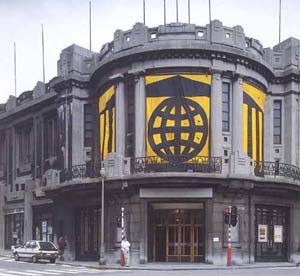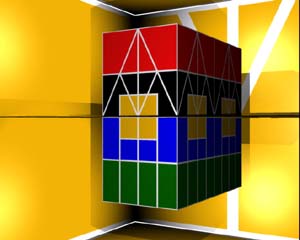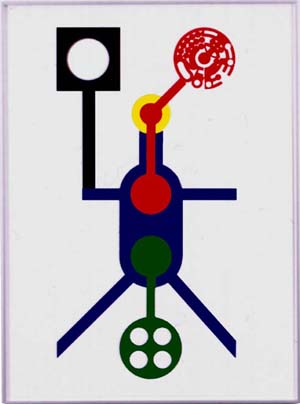L'edicola digitale delle riviste italiane di arte e cultura contemporanea
Juliet Anno 20 Numero 105 dicembre 2001
Matt Mullican
Elena Carlini

Art magazine
Adrian Paci
Maria Vinella
n. 173 giugno-luglio 2015
Case chiuse, corpi aperti
Roberto Borghi
n. 172 aprile-maggio 2015
Yang Xinguang e la materia
Sara Bortoletto
n. 171 febbraio-marzo 2015
Eugenio Re Rebaudengo
Giulia Bortoluzzi
n. 170 dicembre-gennaio 2015
Biennale Architecture
Gabriele Pitacco Marco Gnesda
n. 169 ottobre-novembre 2014
Biennale Marrakech
Emanuele Magri
n. 168 giugno-luglio 2014



A heavy rain is submerging Bolzano, it is a dark day of September, three days after the destruction of the World Trade Center; walking down the streets one is suddenly encountering bright enigmatic figures; they are banners with diverse signs lurking from stone buildings as possible symbols of a novel cosmology. There is something very familiar about these urban ideograms, their geometry definitely belongs to our time, our habits to communicate, giving instructions through pictograms: airports, tunnels, automobile dashboards. At the same time there is something more profound in their solitary standing the rain and the city noise, they are like contemporary poetry filling the urban landscape. Through the city traffic, along an orange construction site, down into the big halls of an ancient hospital; the poetry continues but now it explodes in many diverse directions: subjective, objective, visual, hypnotical. You are now approaching "More Details from an Imaginary Universe" and entering Matt Mullican's world that is our own imagination as well.
The rainwater is gone but the urban feeling is still with you, a giant black and white Piranesian city is expanding from the central hall of the Museion, the contemporary art center that is consistently proposing innovative artists. Then, on another wall, you encounter some tiny details of skin, sand, ice; they are portions of things that exist, somehow, somewhere but do they really exist in themselves? You start to wonder, to reconsider unsettled notions of fictional and imaginary; you continue meandering through physical architecture and virtual one and you know there is not anymore a clear definition, a secure boundary between the two. It was the same with the banners outside: geometrically explicit, publicly accessible and yet enigmatic, arbitrary, ideal. There is something in Mullican's precise and repetitive classification schemes, orderly organized but somehow indeterminate in their meaning, that reminds of On Kawara daily rituals, his meandering and recording like a diligent geographer and yet totally subjective and unpredictable in his "jumping" from one city to the other.
The vivid, lively universe of Matt Mullican is infiltrating the whole building of the Museion, even the people working here seem to operate in a status of renovated energy. Bulletin boards, color cards, engineering drawings from an ancient encyclopedia, glass solids, outlines of the life of Glen - the stick figure - a doll and a dead man, snapshots of life (real?), virtual reality high speed walk tours, architectural spaces in five alternating colors (rigorously black, blue, green, yellow, red), series of objects, writings, drawings, thoughts. Nothing is left untouched and yet you never have the feeling of being overwhelmed, of not being free, you can enter, re-enter, dream, look back and then .... talk to Matt Mullican, who is moving around, setting his artwork like a child re-arranging his favorite toys to play with you.
I am interested in your point of view on the relationship between reality and perception, seeing versus representing, considering that the "fictional" has entered our lives as a novel "reality", blurring the boundaries between objects, language, communication.
-My work exists in five basic areas: the Elemental World, where materiality can exist independent from any subjective point of view, and everything is based on physical laws: the reality. I think of this world as green. Then there is the World Unframed which has to do with everyday experience: working, living, the common unconscious life; this is blue. Then there is the World Framed which is yellow and it begins when you enter the symbolic area, when things are lifted out of their context and re-contextualized in a supposedly neutral realm, shifting from being practical objects to become symbolic ones. The next level is when you have Language, signs and symbols (the color: black); the further one is the Subjective universe which is pure meaning, the color is red and it has to do with the relationship to things independent from the things themselves, which become incidental objects. One could ask: Can the subject exist without the form, without any material whatsoever? No, there must be something physical either brain waves or else. The other question would be: Can an object exist without any information in it at all? But we keep on projecting onto things, as long as they have physical mass, and our relationship is represented by our understanding of them, it is almost impossible to not project onto things. So, the subject without the material is an impossibility and the material without the subject is an impossibility. This is the border of my philosophy.
I am very interested in your performances under hypnosis, which seem to be an open-end experiential relationship shared by you and the "public".
-When I do the work with hypnosis the audience starts to be very nervous because they become voyeurs...
... on someone else fragile moment...
-Yes, I become very fragile; I am not stripping or doing anything obscene, but people still become very nervous because I am stripping in another way. But the artist is curious and is always, in a way, a voyeur.
Can one say that three distinct entities like yourself, your artwork and me (as observer of both you and the artwork) become one "new entity" in the moment of interaction? A kind of shifting reality dependent on the co-presence of the other subjects?
-Yes. In this regard we can also talk about the interaction between these entities and the space of their encounter. Your relationship to this room of the Museion for example, is very different from mine: I grew up in Los Angeles, I live in New York while Andreas Hapkemeyer (the director of Museion) works here everyday and just the fact that you speak Italian changes your view of this space. They are different rooms for each of us but at the same time they are the same room, this is a wonderful kind of problem in a way.
This leads to my next question: You have located your flags over buildings around Bolzano, that is in a urban space, which are your considerations about the notion of public space?
-Public space, but also public understanding of the artistic operation. People want to know what my flags represent, at the same time they project meanings on them. If the object is abstract enough to hold this projection, it will hold it and then it will shift. Since my work is about the interpretative world I am very interested in how people interpret my work, which is different from me. It is a dialogue and when for example people ask: Why is the color for the World Unframed blue? I say: It is arbitrary. I had my reasoning and I can tell you why I chose blue, very easily but that does not make it so for you. It is just a system, your system would be as valid as mine.
Elena Carlini


